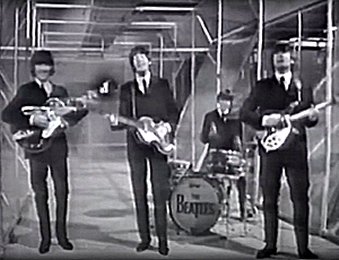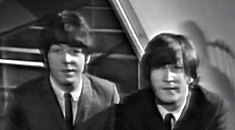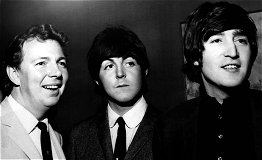Sixties
City presents
a wide-ranging series of
articles on all aspects of the Sixties, penned by the creator of the iconic
60s music paper Mersey
Beat
|
Sixties
City presents
a wide-ranging series of
articles on all aspects of the Sixties, penned by the creator of the iconic
60s music paper Mersey
Beat
|
|||||
|
| This
was the title of a music spectacular conceived by Johnny Hamp* of Granada
Television, the producer and station which had given the group their first
television airing. Hamp had been made Head of Light Entertainment for Granada
and, after deciding he wished to pay tribute to the songwriting talents
of John and Paul, he had discussions with them which resulted in ‘The Music
of Lennon & McCartney’, the biggest spectacular yet produced by Granada
Television, at a cost of £20,000. The programme was produced by Johnny Hamp
and directed by Phil Casson. The 50-minute programme was filmed over a two-day
period in one of Granada’s largest studios, Studio 6, on specially constructed
sets. The completed show was fully networked at 9.40 pm on Friday 17th December 1965. The Beatles had wanted Ella Fitzgerald to sing ‘Can’t Buy Me Love’, but she wasn’t available. French singer Richard Anthony had been due to appear but was involved in a road accident shortly before the recordings and was replaced by Dick Rivers. George Martin led a 25-piece orchestra in a rendition of ‘I Feel Fine’ and Paul introduced the American composer/pianist Henry Mancini with the words, “Now we introduce our favourite composer, Henry Mancini, who is known to all his friends as Hank. Welcome to the Beatles show, Henry”. Mancini played ‘If I Fell’ and Peter & Gordon performed their major hit ‘World Without Love’, with a dozen attractive female models decorating the background. Esther Philips flew in from America especially to perform ‘And I Love Him’ and Lulu, who had been driven up from London by Peter Noone of Herman’s Hermits, belted out ‘I Saw Him Standing There’. The Beatles closed the first part of the show with a rendition of ‘Day Tripper’. Six members of the Liverpool Philharmonic Orchestra appeared under the name ‘Fritz Speigel’s Barock and Roll Ensemble’ to perform ‘She Loves You’ in the style of Mozart. Peter Sellers, with a long wig and Shakespearean costume in the style of Richard III rendered a theatrical interpretation of ‘A Hard Day’s Night’. Billy J. Kramer & The Dakotas performed their hit ‘Bad To Me’ and Cilla Black performed ‘It’s For You.’ She was descending a steep open stairway in a very brief mini-skirt, with John Lennon at the bottom, looking up and commenting "You’re a lovely girl Cilla, a lovely girl", to the amusement of the others. This was followed by Paul McCartney, who began singing ‘Yesterday’ for a period of only 22 seconds before the camera moved to Marianne Faithfull who completed the song. The eighteen-year-old singer was three months pregnant at the time, so the camera concentrated on a head and shoulder shot throughout. Organist Alan Haven performed another interpretation of ‘A Hard Day’s Night’, with backing from drummer Tony Crombie, then The Beatles performed ‘We Can Work It Out’. For the number, John Lennon played harmonium – it was the instrument used in ‘Coronation Street’ which was familiar to viewers of the soap opera as the harmonium in the corner of Ena Sharples’ (Violet Carson) room. |
 |
 |
Among
the spectators who were witnessing the production were members of the ‘Coronation
Street’ cast and disc jockey Jimmy Savile. Also appearing on the special
was the Spanish dance star Antonio Vargas who performed ‘She Loves You’
in the flamenco style. ITV entered the show for the Golden Rose of Montreux
Awards. Incidentally, Esther Phillips had recorded a version of ‘And I Love Him’, issued by Atlantic Records on 22nd May 1965. Paul was so pleased with her rendition of the song at the time that he said it was the best cover version of any Beatles number. When they were planning the special John and Paul sent a cable to Esther, who was performing in cabaret in Bermuda, inviting her to sing the number on the show. She completed her engagement in the West Indies and flew to Manchester to appear in the special. She was thrilled that they’d contacted her and said: “I wanted so much to meet The Beatles in the States but every time I hit town on my own tour, they’d either just been or were coming the next week. I never met four young men before who are all in the genius class”. Esther died of liver and kidney failure on 7th August 1984. |
| Part
1 The George Martin Orchestra - a medley including 'I Feel Fine' that ends with a cut to John Lennon and Paul McCartney playing a cymbal with drumsticks Peter and Gordon - 'A World Without Love' introduced by John Lennon and Paul McCartney after the pair have listened to some cover versions of their songs played on set props such as a Victrola, a reel-to-reel tape machine, and a transistor radio Lulu - 'I Saw Him Standing There' Alan Haven and Tony Crombie - 'A Hard Day's Night' Fritz Spiegl's Barock and Roll Ensemble - a medley including 'She Loves You' – introduced by John Lennon and Paul McCartney. The ensemble members wear Baroque-era costumes and powdered wigs, and are surrounded by a crowd of women dressed in contemporary Mod fashions The Beatles - 'Day Tripper' accompanied by a group of go-go dancers Part 2 Paul McCartney / Marianne Faithfull - 'Yesterday' starts with Paul McCartney miming to The Beatles' 1965 track and cuts abruptly, at the start of the second verse, to Marianne Faithfull miming to her recent recording, which she sings in a different key Antonio Vargas - 'She Loves You' preceded by John Lennon and Paul McCartney walking around the set while discussing foreign-language interpretations of their songs Dick Rivers - 'Ces Mots Qu'on Oublie un Jour (Things We Said Today)' Billy J. Kramer & The Dakotas - 'Bad To Me' Cilla Black - 'It's for You' Part 3 The George Martin Orchestra - 'Ringo's Theme (This Boy)' accompanied by a group of go-go dancers Henry Mancini - 'If I Fell' introduced by McCartney Esther Phillips - 'And I Love Him' introduced by Lennon Peter Sellers - 'A Hard Day's Night' The Beatles - 'We Can Work It Out' |
 |
*
Sixties City - Johnny Hamp During the 1950s John Hamp trained as a Granada cinema manager in Kingston, moving to the group's main venue at Tooting to handle a 1953 Frank Sinatra concert. He was to present many more, with Johnnie Ray, Guy Mitchell, Frankie Laine, Tommy Steele, Cliff Richard and Gene Vincent. He also organised personal appearances at Granada theatres of many of the Hollywood stars of the day including Jayne Mansfield, Bob Hope and Victor Mature. In 1961 Hamp moved to Granada's television division while retaining his responsibilities for stage show management, and booking acts for television productions such as Chelsea at Nine. Granada boss Sidney Bernstein saw Hamp's potential as a producer and put him in charge of several television quiz shows including Spot the Tune, Criss Cross Quiz and Take A Letter. By the mid 1960s Hamp was based at the new company headquarters in Manchester where he was involved in the making of the regional news magazine programme Scene at 6.30. Subsequently he was responsible for a number of successful television specials, mainly featuring blues based American artists. These included Sarah Sings and Basie Swings (1963) with Sarah Vaughan and Count Basie; I Hear the Blues (1963) featuring Memphis Slim, Muddy Waters, Sonny Boy Williamson and Willie Dixon; The Blues and Gospel Train (1964) with Sister Rosetta Tharpe; Whole Lotta Shakin' Goin' On (1964) with Jerry Lee Lewis and Gene Vincent; It's Little Richard (1963). He was a great influence on the success of The Beatles by giving the band television exposure in 1962 at which time they were little known outside Liverpool. |
|
Article
Text
UK
web hosting by
|